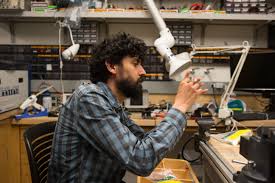Manu Prakash hopes his simple idea, easy-to-use one dollar microscopes, will encourage children from all of the world to fall in love with science.
As part of the Distinguished Lecture Series, Manu Prakash a professor of bioengineering at Stanford University, described how he shocked the scientific world with his invention of the foldscope, a small, origami-like paper microscope priced at only one dollar.
Prakash said the idea of the foldscope came to him when found struggling with the question, “How do I bring the joy of science I have to other people?” Prakash said the foldscope is supposed to be a tool that fosters a desire to learn in children through simple observation.
Raised in India, Prakash critiqued current education systems, which he said don’t teach how to properly observe, an effective way of learning for those who can’t afford an education in underdeveloped countries.
“Teachers are trained to cover content not encourage observations,” Prakash said.
Prakash’s passion for making tools like the foldscope lies in his belief that simple tools allow for curious observation. Prakash describes his work as “curiosity driven discovery.”
Prakash, the 2016 MacArthur Foundation “genius” grant award winner, attributes his success to his work ethic. The award is given to individuals who demonstrate “originality, insight, and potential.”
“If tools are available they can change the way lives are lived,” Prakash said. “We all have enormous power to make change.”
Prakash said he envisions a foldscope club of global citizens who share the tool with their community. Foldscope has the power to make necessary education changes on the ground level, Prakash said.
Prakash’s lab announced Sunday they have jump started a campaign to raise funds for 1,000,000 foldscopes that will be shipped to schools around the world.
“This challenge is a call to the community to engage with us,” Prakash said.
Despite his achievements, Prakash insisted his work is far from over. He wants to continue spreading his love of science and observation around the world to engage more children to learn, even in the simplest way.
“Every time you make an observation, look closer,” Prakash said.


